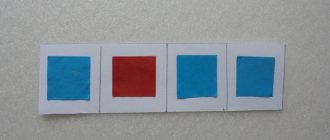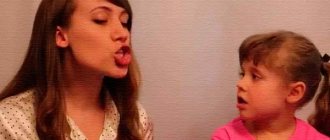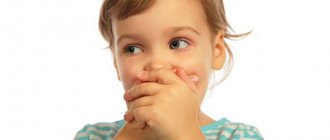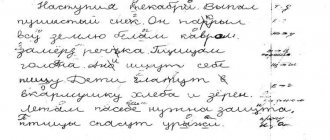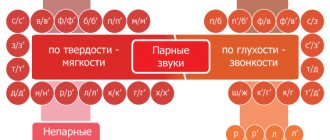Stages of speech therapy work when correcting disorders.
Sound pronunciation technologies.
Correction of sounds is carried out in stages: preparatory, sound production, sound automation, differentiation. Each stage has its own tasks and content of work. At each subsequent stage, simultaneously with the development of new material, there is a partial repetition of the material from the previous material.
I. Preparatory .
Purpose of the work: to prepare the speech-auditory and speech-motor analyzers for the correct perception and reproduction of sound.
Direction of work: formation of precise movements of the organs of the articulatory apparatus, directed air flow, development of fine motor skills of the hands, development of phonemic hearing, practicing reference sounds, hand massage, self-massage of the fingers (massage balls can be used), subject-based practical activities (lacing, modeling, mosaic , construction set, weaving, stringing games with handkerchiefs, etc.):
a) The formation of movements of the organs of the articulatory apparatus is carried out mainly through articulatory gymnastics, which includes exercises for training the mobility and switchability of organs, practicing certain positions of the lips and tongue, necessary both for the correct pronunciation of all sounds, and for each sound of a particular group. Exercises should be targeted: it is not their quantity that is important, but the correct selection and quality of execution.
First, the exercises are performed at a slow pace in front of a mirror. After the child learns to perform the movement, the mirror is removed.
With the help of leading questions, the child determines what his tongue (lips) does, where it is located, how wide, narrow it is, etc. etc.
For each exercise, in accordance with the action being performed, a picture-image is selected (an image is a visual representation of something), which serves as a model for imitation of the object or its movements when performing articulatory gymnastics exercises.
The teacher performs exercises in front of the mirror together with the child. To do this, he must show correct articulation, feel the position and movements of his organs of the articulatory apparatus without visual control, which requires a certain skill achieved through training.
Pronouncing most sounds of the Russian language requires b) a directed air stream, the development of which is carried out simultaneously with articulatory gymnastics, since the cheeks, lips, and tongue take an active part in the formation of the air stream. The following exercises are sequentially given to strengthen the muscles of the cheeks - inflate the cheeks and hold air in them (“Inflate two balloons”), retract the cheeks with closed lips and with the mouth slightly open (“Skinny Petya”); to produce a directed air stream - do not puff out your cheeks, through your lips brought together and slightly pushed forward, forming a round “window” in the middle, blow off any soft object (a cotton ball, a paper snowflake, etc.) from the palm of your hand raised to your mouth, or blow onto one lying on the table pencil so that it rolls.
Simultaneously with articulatory gymnastics and exercises for developing a directed air stream, c) fine motor skills of the hands are practiced.
Children with insufficiently developed fine motor skills require increased attention during physical education classes (especially when exercises are carried out to develop coordination of movements), music classes (especially when musical-rhythmic movements are carried out). You can use, for example, finger games, accompanied by rhymes and nursery rhymes; exercises without speech accompaniment (finger gymnastics); games and activities with toys and objects, visual activities (coloring pictures, tracing contours, etc.), modeling from plasticine, shading, etc. etc. All this contributes to the development of the muscles of the fingers and hands.
d) Self-massage of the hands and fingers - for example, rubbing the palms up and down; kneading, then rubbing each finger lengthwise and crosswise. You can also use pencils, walnuts, massage balls.
One of the main types of work on the development of e) phonemic hearing at this stage is to educate the child’s ability to perceive the difference between correct and distorted sounds. It is necessary to give him the opportunity to listen to the speech therapist’s example and compare it with his own distorted image. In this way, we direct his auditory attention to these sounds, show the boundary in their sound and develop an incentive to overcome the violation.
When a child replaces one sound with another, differentiation is made by hearing between the desired sound and its substitute. Pictures-symbols serve as didactic material. For example, a child replaces the sound (p) with the sound (l), then he must give the picture “Tiger”, while saying “Listen to how the tiger growls: rrrrr.”
Then give a picture of a flying plane, saying: “The plane is flying in the clouds, you can hardly see it, but you can hear it humming: “llll.”
Next, covering your mouth with a piece of paper, you need to pronounce either the sound (r), then the sound (l). And the child silently shows the corresponding picture-symbol (that is, sounds are differentiated by ear, according to acoustic characteristics).
One of the important areas is e)) practicing reference sounds - similar to articulation disorders, but pronounced correctly by the child. Practicing reference sounds involves: clarifying the articulation of sound and its correct pronunciation in isolated form, in syllables, words, sentences.
For the sound (w) the references are (t), (s). The sounds (w), (t) are identical in place of formation (front-lingual), the tip of the tongue when pronouncing them is at the top. By processing (t), we achieve the ability to raise the tip of the tongue to the alveoli. The sounds (w), (s) are the same in the method of formation (slotted). By practicing (c), we achieve a directed air stream running down the middle of the tongue. By combining these two worked elements, we achieve the correct pronunciation of the sound (w). For ( l) the supporting ones are ( t), ( s) - ( ( t) gives the rise of the tip of the tongue to the alveoli, and ( s) – the rise of the middle-posterior part of the tongue to the palate), for ( p) - ( d) and ( c) – ((e) practices raising the tense tip of the tongue upward, (c) – directed air stream).
By practicing reference sounds, we already at the preparatory stage achieve their clear pronunciation in syllables, words, phrases, which helps in developing good diction; We teach the child to identify the reference sound in syllables, words, phrases, which develops his phonemic hearing and gives a practical understanding of such concepts as “sound”, “word”, “sentence”. All this contributes to the development of speech-motor and speech-auditory analyzers, the formation of skills in the analysis and synthesis of words and, accordingly, faster and more successful production and automation of impaired sound.
II . The stage of formation of primary pronunciation skills.
Goal: elimination of defective sound pronunciation; development of skills and abilities to differentiate sounds that are articulatory and acoustically similar; formation of practical skills in using corrected (phonetically pure, lexically developed, grammatically correct) speech.
1. Sound production.
Purpose of work: to achieve the correct sound of isolated sound.
Direction of work: combining the movements and positions of the organs of the articulatory apparatus worked out at the preparatory stage and creating an articulatory base for a given sound, adding an air stream and voice for sonorant and voiced sounds. Practicing the pronunciation of an isolated sound.
2.Sound automation.
Purpose of the work: to achieve the correct pronunciation of sounds in phrasal speech.
Direction of work: gradual sequential introduction of the given sound into syllables, words, sentences and into the child’s independent speech.
a) Automation of each corrected sound in syllables:
As it is staged, it can be carried out either individually or in a subgroup:
* S, Z, Sh, S, Z, L are automated first in forward syllables, then in reverse syllables, and lastly in syllables with a consonant cluster;
* Ts, Ch, Shch, L - vice versa, first in reverse syllables, then in forward syllables and with a confluence of consonants;
* P, P can begin to be automated and simultaneously generate vibration.
b) - Automation of each corrected sound in words:
It is carried out following traces of automation in syllables in the same sequence. As you master the pronunciation of each syllable, it is immediately introduced and fixed in words with that syllable. To carry out work on automating sounds in words, children with similar defects are united into subgroups. All further correction work is carried out in subgroups.
c) - Automation of sounds in sentences.
Each word practiced in pronunciation is immediately included in separate sentences, then in short stories, nursery rhymes, pure sayings, and poems with this word are selected.
3. Differentiation of sounds.
Purpose of the work: to teach children to distinguish between mixed sounds and to use them correctly in their own speech.
Direction of work: gradual sequential differentiation of mixed sounds according to motor and acoustic characteristics (first isolated, then in syllables, words, sentences, in independent speech).
Simultaneously with all types of work on differentiating sounds, vocabulary work is also being carried out.
When differentiating sounds, poems and stories are selected (saturated with the necessary sounds), which the child memorizes, retells, and at the same time develops coherent expressive speech based on the correct pronounced sounds.
Thus, each lesson requires careful preparation from the speech therapist, taking into account the speech, mental, psychological and characterological characteristics of the child.
III . Stage of formation of communication skills.
Goal: to develop in children the skills and abilities to accurately use sounds in all situations of speech communication.
Direction of work: modeling and use of various situations of verbal communication to develop communication skills.
In parallel with correctional work on the development of articulation in children, phonemic processes are improved. At the preparatory stage, exercises are used that promote the development of speech hearing, activating children's attention to the speech of others and their own speech. At the stage of setting sounds and their automation, work is underway to form correct phonemic representations. Along with the articulatory characteristics of the sound, its acoustic characteristics are specified (duration of sound, pitch, presence of vibration, etc.). At the stage of differentiation of sounds, various methods of distinguishing sounds are used: the method of demonstrating the articulation of differentiated sounds (forms: visual, auditory, kinesthetic, tactile); a method of phonemic analysis, which traditionally includes three language operations: – phonemic analysis (singling out a sound against the background of a word, determining the position of a sound in relation to other sounds, etc.); phonemic synthesis (composing words from a given sequence of sounds, composing words with a given number of sounds, etc.); phonemic representations; connection between sound and letter.
Technology for staging different groups of sounds.
There are three main ways to produce sound:
1 . Staging sounds by imitation is the first method that a speech therapist should use when eliminating impaired sound pronunciation.
By imitation they make hissing sounds, paired soft sounds, paired ringing sounds; by imitation you can put in the missing sound.
With this method of production, the child’s attention is fixed on the movements, positions of the organs of the articulatory apparatus and the sound of the phoneme. The role model is an isolated sound or a sound in a syllable in the speech of a speech therapist. In addition to hearing, vision and kinesthetic sensations, tactile-vibration control is also used: with the back of the hand, for example, the quality of the air stream or the functioning of the vocal folds is checked. At the stage of production, pictures-symbols, dummies, and articulation models are widely used. In this way, the child creates a basis for conscious sound reproduction.
The second way is with mechanical assistance .
. The mechanical method involves the use of auxiliary means: spatulas, probes, the child’s finger. This method is used when a child does not have enough visual, auditory and tactile-vibration control. Using some initial articulation, the speech therapist, with mechanical assistance, corrects the position of the articulation organs.
* For example: when making the sound “sh”, the child independently cannot place the front part of the tongue at the level of the anterior part of the hard palate, but holds the wide tip of the tongue at the upper alveoli; the speech therapist can use the child’s index finger to lightly press from below on the front part of the back of the tongue and move the body of the tongue along with the tip a little deeper into the mouth, behind the alveoli.
* Having invited the child to pronounce the sound (s), the speech therapist, using the flat handle of a teaspoon or a spatula, lifts the wide front edge of the tongue by the upper teeth and puts the sound (w).
*If you pronounce the sound (p) in a whisper, you can get the pattern of the sound “sh” if you invite the child to stop the vibration of the tongue while maintaining the air stream.
The sound “sh” is also placed from the pattern of the sound “t”, if you pronounce the latter with aspiration, lightly touching the tip of the wide tongue not with the upper teeth, but with the alveoli or the palate behind the alveoli. Then the child is asked not to touch the palate with his tongue, but only to bring his tongue to the palate and continue to blow on it with aspiration - this is how the necessary position of the tongue is formed. By connecting to the formed position of the tongue the work of rounded lips extended forward with a “horn” in combination with a long oral exhalation, the speech therapist obtains a sound corresponding to the sound “sh”.
Sound production from articulatory gymnastics is an effective method of sound production, which allows you to qualitatively work out the missing elements of the structure, to form stable kinesthetic sensations, which will be the key to the quick and lasting introduction of sound into the child’s speech.
The third method is mixed , when all possible methods are used to achieve the final goal - establishing the correct pronunciation of an isolated sound.
*The sound “r” is placed with mechanical assistance from the reference sound “zh”. The child is asked to smile, open his mouth slightly, exposing the upper and lower teeth, and, without closing the corners of his lips, pronounce “w-w-w” for a long time. With the described position of the lips, the tip of the wide tongue will move slightly forward to the alveoli, which corresponds to the articulatory structure of the sound “r”. Against the background of the child pronouncing the sound “zh”, the speech therapist uses a ball probe to make short oscillatory movements from left to right along the lower side of the front part of the back of the tongue, as a result of which the sound “r-r-r” occurs.
-From [d]: exercises “Woodpecker”, “Drummer”. Quickly and abruptly “knock” the tip of the tongue on the upper alveoli, pronouncing [d] = “dr.”
-From alternating [t] and [d]: exercise “Train” (imitation of the sound of wheels) = “tr-dr.”
-From the combination “j”: exercise “Start the engine” = “drrr”. 4. Setting in 2 stages: 1) fricative [p] from [zh], [z] or [d], possibly from the syllables “zha”, “for”, “yes”;
- mechanical achievement of vibration using a ball probe = [p], syllables “ra”, “dra”.
*Sound "Ш"
By imitation and mechanically: raising the tip of the tongue with a probe when pronouncing “sya” or “sya” = [sch] or the syllable “sha”.
*Soft consonants.
-By imitation.
It involves the auditory perception of soft sounds and the visual perception of the articulation of these phonemes when comparing them with paired hard phonemes (pa - pya, apa - apya, etc.).
The child is asked to: – pronounce the vowel [i] for a long time, and then the syllable pi; - repeat the same syllable in a whisper, gradually shortening [i], resulting in a distinct [p'], with some aspiration; - go to the sound combination api, which should be pronounced first loudly, then in a whisper, then so that the first vowel is pronounced loudly, and the second in a whisper and briefly: the combination ap is obtained; – having consolidated the resulting soft sound [p] - [p'], you can move on to the open syllable pya, first separating the consonant phoneme from the vowel ([p'] - [a]), and then merging them; – then introduce syllables and words with other vowels.
-Mechanical method. The initial consonants used are [t], [d], [n], since these sounds are simple in their structure and are pronounced with half-open teeth and lips. When pronouncing [t] or a syllable (ta), hold the tip of the tongue with a spatula behind the lower incisors (pressing the front edge of the tongue): it turns out [t'] in an isolated form or in an open syllable (tya, tya, tya). In a similar way, the syllable (at) is obtained from the syllable (at).
The same mechanical method is used when making sounds [d'] from [d], [n'] from [n].
With all three methods of producing any sound, you should always use verbal instructions, visual, auditory, tactile-vibration control and reference sounds.
Thus, when producing sound, all analyzers must work simultaneously: visual, auditory, motor, tactile.
Types of disorders of the pronunciation aspect of speech in speech therapy
Even a temporary delay in speech development can adversely affect the child’s overall development. Mastering correct speech is a necessary condition for mastering literacy and studying at school. In speech therapy, certain types of disorders are distinguished, which include alalia, dyslalia and dazarthria.
Alalia
Alalia is a complex disorder of speech development. It denotes the immaturity of all parts of speech as a result of the fact that the speech zones in the cerebral cortex were affected before birth and from 0 to 3 years.
In turn, alalia is divided into:
- motor;
- sensory.
It happens that a child has a mixed form of the disease, but one type is predominant. Motor (expressive) alalia can be corrected, while a child with sensory (impressive) alalia has physical hearing but does not understand what others say.
Dislalia
Dyslalia refers to disturbances in the pronunciation of sounds, but the child has good hearing and a normally developed articulatory apparatus. A child with this diagnosis misses, replaces, mixes or distorts sounds when pronouncing them. In speech therapy, dyslalia is considered a common disease.
Approximately 25-30% (sometimes 50%) of preschool-age children and 18-20% of primary school-age children are diagnosed with this speech disorder. If it is not corrected in time, in the future the child will not be able to fully master writing, and disorders such as dysgraphia and dyslexia may develop.
Dysarthria
With dysarthria, the central part of the analyzer (speech motor) is affected and the functioning of the muscles of the speech apparatus is disrupted. The child’s speech motor skills, sound pronunciation, and speech breathing suffer, so speech is inarticulate and slurred. If dysarthria is diagnosed, then a speech therapist, neurologist, or psychiatrist works with the baby.
Features of articulation
The problem of incorrect sound pronunciation (if the child does not have other speech problems, for example, dysarthria) of sonorant sounds is the difficulty in their articulation. This is especially true for R, so speech therapists advise parents not to panic if their child does not “growl” at three years old. The articulatory apparatus must be prepared, which happens by the age of 4-5, so be sure to do articulatory gymnastics with your child.
When pronouncing P, the organs of the articulatory apparatus occupy the following position:
- the mouth is open, the lips are in the position of the vowel sound following P;
- the tongue should be wide, located behind the upper teeth and touching the alveoli, the lateral edges should be raised; it is shaped like a small ladle;
- the soft palate is raised;
- vocal cords vibrate.
In addition to the correct position of the organs of the articulatory apparatus, a strong air stream is needed, because when exhaling it is directed to the tip of the tongue, resulting in its vibration and a “rumbling” sound.
The tip of the tongue should vibrate, not the small tongue or its side. You can check the direction of the air stream using a strip of paper: if pronounced correctly, it will sway.
General recommendations
The sequence of sound production in speech therapy is regulated by certain stages.
When setting and correcting sounds, the following is important:
- work on the development of auditory perception, attention and memory; phonemic awareness; articulation;
- personal example (an adult and a speech therapist must pronounce sounds correctly);
- timeliness of correction work (for most sounds the age limit is 4-5 years, only the sound P is corrected at 6 years).
Examples of tasks for children to automate the pronunciation of problematic sounds
Possible tasks for automating problematic sounds:
- name what is depicted in the paintings;
- story based on the picture;
- memorizing sayings, simple sayings, short poems;
- repetition or retelling of short phrases, sentences, texts.
You can carry out the sequence of sound production yourself, but it is better to seek help from a professional. In speech therapy, there are several methods for correcting sound pronunciation, which should be carried out by a speech therapist, and at home, parents can continue the lesson.
Author: Inna Krylova
Article design: Vladimir the Great
Stages and sequence of sound production
The sequence of sounds in speech therapy is mainly determined over a long period of time. During the work, parents, speech therapists and, of course, the child himself participate. There is a certain system according to which the process of producing sounds is more effective.
The sequence of sound production in speech therapy is divided into the following stages:
- Preparation.
- Actually working on the production of sounds.
- Consolidating the correct sound pronunciation in a syllable, word, phrase, sentence (the principle is from simple to more complex).
- The difference between sounds, highlighting a specific sound, designating its place in a word.
You can move on to the next stage if the preschooler has no difficulties at this stage. If you neglect even minor errors, then in the future they will be much more difficult to correct.
You can set the sound in different ways:
- thanks to articulatory gymnastics and massage;
- imitating;
- mechanically (using speech therapy instruments - probes);
- from other sounds (many sounds are similar in articulation).
Reference sounds in speech
In speech therapy, reference sounds are understood as sounds that are similar to problematic sounds in articulation terms, but they are pronounced correctly by children.
Based on the reference sounds, it will be easier to teach a preschooler to correctly pronounce or pronounce complex sounds (hissing, whistling and sonorous). The reference sounds for S are I, F, for Zh - V, Z, for C - T, S.
Conditions for fixing sounds in speech
The success of sound production depends on many factors: the frequency of classes, the degree of problems with sound pronunciation.
Effectiveness can be divided into the following conditions that must be met:
- development of phonemic hearing;
- control of a speech therapist, parent and self-control;
- awareness of why these classes are needed (motivation). Parents are encouraged to praise their child even for minor successes.
Each of these conditions is complementary.
What sounds does the speech therapist start with?
The sequence of sounds in speech therapy begins with those sounds that the child already pronounces at the age of 3 years. The sounds are predominantly simple for the articulatory apparatus; they are also reference (more complex sounds are based on them). Such sounds include vowels and consonants: B-B, M-M, V-V, P-P, T-T, D-D, K-K, G-G, H-H, F-F, N -NY, Y.
The sequence of sounds is performed gradually. In speech therapy, it is recommended to start working on sounds that are familiar to the baby and he pronounces them well.
